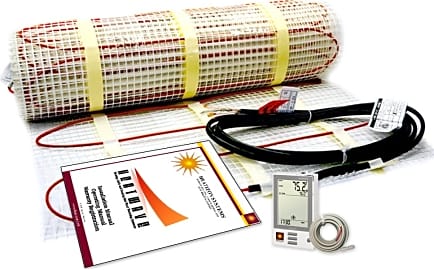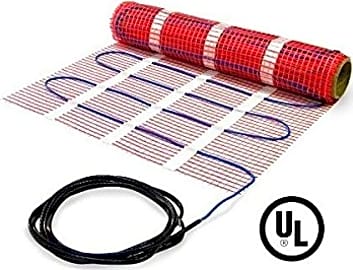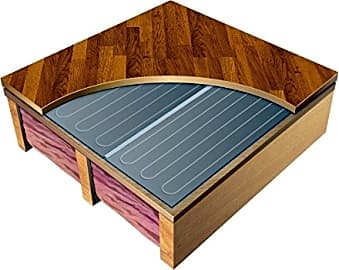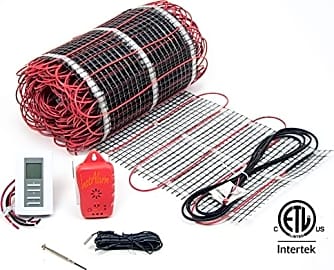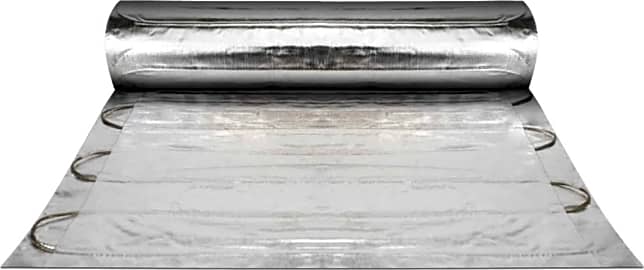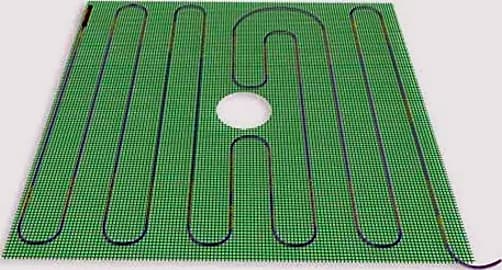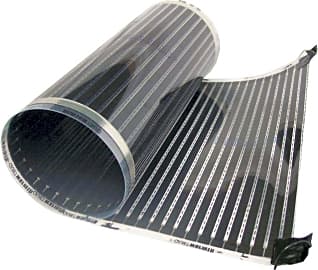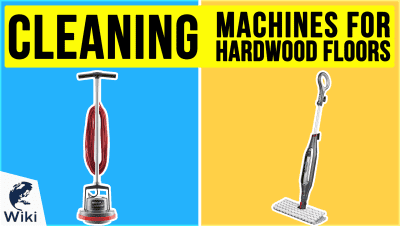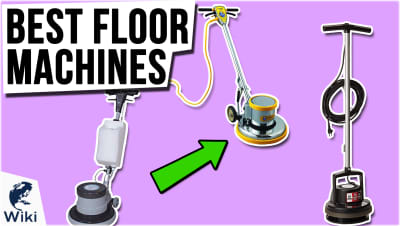The 10 Best Underfloor Heating Mats

This wiki has been updated 34 times since it was first published in March of 2017. Installed between hardwood or tile and their subfloors, heating mats release radiant warmth that'll save your bare feet from unpleasant, chilly surfaces on winter mornings. Controlled by a thermostat, they come in several different sizes to suit various rooms, and cost less than you might think. They're suitable for many types of flooring, including laminate, vinyl, and carpet. When users buy our independently chosen editorial choices, we may earn commissions to help fund the Wiki.
Editor's Notes
November 26, 2020:
Modern electrical underfloor heating is becoming more efficient, more versatile, and easier to install, making it a popular choice for new builds and renovation projects alike. They can be installed on almost any floor types from carpet to hardwood or stone, and depending on the model chosen and the local climate, they can remove the need for auxiliary heaters such as radiators or Panel heaters.
In this update, we completed the list with several new models that have recently become available, while removing the Happy Man Floors 94445 due to issues with thermostat malfunction and its particularly short warranty. The WarmlyYours Environ is similar to the ThermoFloor Underlayment in that they are both designed for use under laminate and wooden floors. Furthermore, the former offers more versatility as it is also suitable for carpet and vinyl floors, too. Similarly, the QuietWarmth Ultra-Thin is a good choice for laminate floors due to its .016 of an inch thickness, however, its heat output is lower than most, and while it stops floors from feeling chilly, it won't actually heat the room.
For use under tiles or natural stone, the heating element is usually attached to some form of a mesh that is bound to the floor with the adhesive. The SunTouch 195283, the HeatTech 120V Electric, the HeatWave System, and the Warming Systems Radiant Floor are all such systems, and choosing between these will depend on the size of the area to be covered and the quality of the accessories. The SunTouch is a good choice for small areas as each mat is only six feet long, whereas, for larger areas, the HeatTech is available in lengths of up to 61-feet. The HeatWave and the Warming Systems both come with good-quality thermostats, the former being rated for use in wet locations while the latter includes an installation monitor that can be used to test the integrity of its heating element. Finally, the Schluter Ditra Signature is notable due to its unique mat design, which provides insulation and deflects the heat up through the floor, promising savings of up to 15 percent in energy consumption.
October 17, 2019:
During this round of updates, we eliminated a previously ranked option from SunTouch, due to availability issues. In its place, we’ve included a smaller option from the company – the SunTouch 195283 – which is limited in usefulness due to its size (15 squre-feet). However, given its notably-affordable price, we considered it well worth ranking, as an economical means of heating a half-bathroom, among other things.
While we always recommend enlisting the assistance of a reputable, licensed electrician when it comes time to hardwire any of the options in this category, it’s also worth mentioning that installing the actual underlay is quite a simple process. If you have even the slightest propensity for do-it-yourself projects, then it’s unlikely that this is beyond you. The only real safety concern you’ll face is the possibility of knicking or otherwise damaging the heating element during installation, which could potentially cause micro-arcing, which might present a fire hazard. To this end, don’t forget to resistance test the install before laying down your final floor, and perhaps consider an option like the Happy Man Floors 94445 or the Warming System Radiant Floor, which include installation monitors that will enter an alarm state in the event of a damaged cable.
October 05, 2018:
Removed a Heatweave product due to concerns about availability, and reviewed all entries to make sure they still deserve a place on the list. Added a new Warming Systems heat mat for its good value with quality features.
A Brief History of Underfloor Heating
By the 1930s, hot water had replaced steam in many systems, as the water could hold its high temperatures for longer periods of time.
It's something you never get used to: you've been laying all snug and warm in your bed, but then nature calls, so you step out onto the floor — and the icy hand of Death grabs the bottom of your foot.
It turns out that humans have been trying to avoid that cold touch for virtually our entire history. As far back as 5000 B.C.E., our ancestors were digging trenches in caves to re-distribute the smoke from their fires in order to warm the rest of the cavern.
About two millennia later, fire hearths were introduced in Korea, doubling as ovens in addition to heaters. The Chinese created heated stone beds called "kangs," around this same time, and would use them for centuries, especially in monasteries.
The Romans borrowed this technology in the 3rd century B.C.E. when they developed hypocausts, which are spaces underneath beds and baths designed to trap hot air. In order to accommodate these hypocausts, the Romans raised their floors off the ground with pillars, and then layered the chamber with tile and concrete.
Hypocausts were largely abandoned everywhere except certain Asian and Mediterranean countries by the 5th century C.E., as people turned instead to centrally-placed fireplaces to heat their homes.
It would be greenhouses that would re-introduce the idea of heated floors to the masses — or to Europe, at least. The invention of the hot water boiler in the late 17th century allowed people to use pipes to transport steam, which was then released via flues in the floors and walls to keep plants at the necessary temperature.
By the 1930s, hot water had replaced steam in many systems, as the water could hold its high temperatures for longer periods of time. One of the biggest proponents of underfloor heating was the famous architect Frank Lloyd Wright. He installed radiant heating systems in many of his most famous creations, helping to normalize their use.
This hot water was usually carried in copper pipes, and in the years following WWII, an American developer named William Levitt tried to use those pipes to warm giant housing installations for returning GIs. Levitt's successful installation of these systems in large-scale housing developments proved that they were both useful and cost-effective for residential use.
By the 1980s, many Scandinavian homes and commercial buildings used floor heating systems to regulate temperature, prompting their spread across most of Europe.
Many modern HVAC systems were designed to integrate with underfloor heating mats, allowing users to customize the temperature in every surface of their home. Not every house has underfloor heating mats, of course, but their popularity is growing, especially among environmentally-conscious homeowners, as these systems allow for efficient heating and cooling without sacrificing comfort.
Now, the next time you step out of bed on a cold winter morning, you'll be happy to discover that Death's hands are actually quite pleasantly warm.
Things to Keep in Mind Before You Buy
While underfloor heating mats are certainly luxurious, that doesn't mean they're right for everyone. There are a few factors you should take into consideration before you take the plunge.
The most important thing you should know is that these mats are not easy, nor particularly cheap, to install. Yes, you might be able to recoup your investment on energy savings and increased home value, but that initial outlay won't be cheap — and expect lots of turmoil in your house while your floors are ripped up during installation.
While they can be installed under just about any kind of flooring, including wood, tile, stone, and even carpet, thick material will dissipate the heat.
In fact, it may be better to hire a contractor to install them for you, as that saves you from having to deal with building permits, and improperly installed heating systems are potential fire hazards. Speaking of which, don't put flat-bottomed furniture over the cables, as that can restrict air flow and also potentially start a fire.
Most mats can't be cut or altered, so if you have an unorthodox floor plan, you might have issues fitting them in all the places they need to go. However, you may be able to find one or two models that allow you to trim them — but never cut the wires.
The thickness of your floors is something to consider as well. While they can be installed under just about any kind of flooring, including wood, tile, stone, and even carpet, thick material will dissipate the heat. Anything wood or carpet thicker than about three-quarters of an inch will limit how much heat penetrates. On the other hand, stone and tile conduct heat, improving the system's performance.
All this being said, you're unlikely to regret taking the plunge (at least once everything's installed, anyway). Stepping down onto warm, toasty floors during the height of winter is one of the most opulent experiences in the world, just behind eating caviar off a Pop-Tart.
How Underfloor Heating Mats Work
Underfloor heating mats are thin layers of carpet with electrical cord running through them. The cables heat up due to electrical resistance, and the warmth then spreads evenly throughout the fabric. It's kind of like a giant heating pad, except for the ground.
The cables heat up due to electrical resistance, and the warmth then spreads evenly throughout the fabric.
The mats are placed just under the floor, and above a layer of insulation that ensures that the heat travels upwards, instead of dissipating in all directions.
They usually come with their own thermostats, but many can be connected to your home's existing thermostat. You can set it so that the heating element turns on automatically if the floor reaches a certain temperature, but that requires installing a sensor under the floor.
Since they use radiant heating, instead of pushing treated air, there's generally less heat lost, increasing their energy efficiency. Not only that, but since they're not blowing all over your home, you don't have to worry about them stirring up a ton of dust and allergens.
You'll need to pair them with another heating system for your home, though, as they're not suitable for warming anything above the ground. Either that, or you could just lay on the floor all the time. It's what we do! (We also cry a lot.)



